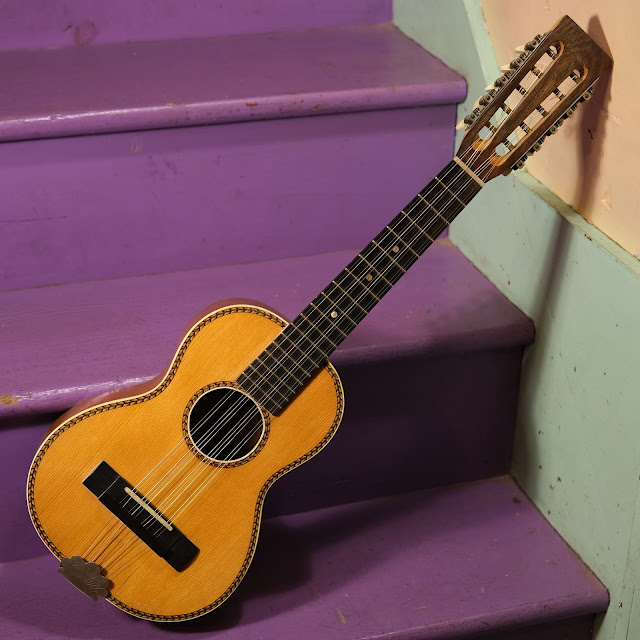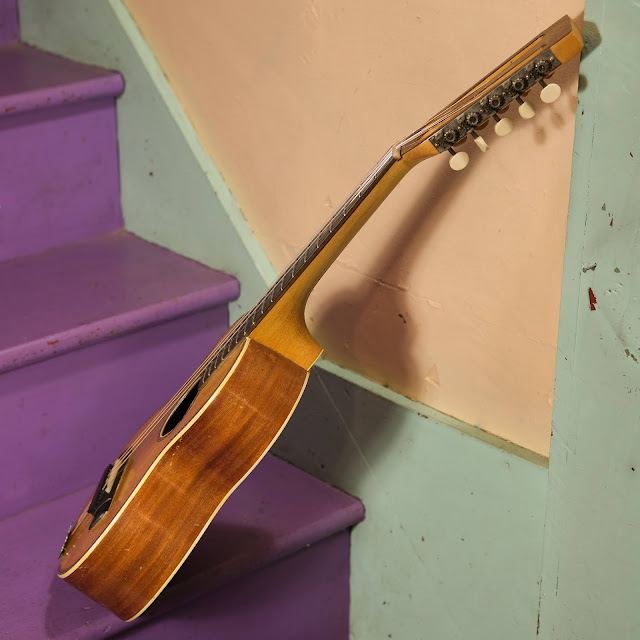1930s Regal Spruce/Mahogany Fancy Tiple
I've worked on a bunch of old tiples in the past and Regals are my yardstick to measure other ones by (save Martins -- which are always excellent). I owned one that was very close to this style for many years. The Regals sound more "open" and full to my ears than comparable instruments by Harmony and Oscar Schmidt, who were the other mass-market tiple makers in the '20s and '30s. The Schmidts are pretty nice, though, too.
This one's in for consignment and arrived in already-worked-on condition. I had to overhaul it to get it to play on-the-dot, but the neck had already been reset. Now that it's done-up it has that jangly, plunky, pocket-12-string sound that one wants to hear from these -- and it plays perfectly. I like it best flatpicked/crosspicked or with metal fingerpicks, but uke-style bare-fingers strummers will find it nice, too.
Regal changed the scale length on their tiples from a little over 17" in the '20s down to 16 3/4" and that relaxed a bit of tension on the later models like this '30s one (shorter scale = less tension at the same pitch and string gauge). Nevertheless, I think traditional stringing (anchored at the bridge) is generally a bad idea on tiples. The tops aren't built tough enough. So, as you can see here, I used a tailpiece to give this mandolin-style loading that's then passed through the rear of the bridge like one sees on many South American and Latin American tiple-style instruments.
Other (related) instruments like lauds and bandurrias use the same technique -- which gives you the traditional "glued bridge" sweetness/warmth to the sound while also reducing the curling/warping effect of the tension on the top. Once you tailpiece a Regal tiple like this you immediately notice more volume, an easier feel on the fingers, and a more open sound. The instrument also doesn't want to die anymore. It's a win-win.
Repairs included: (previously-done) neck reset and new bridge -- and (by me) a fret level/dress, side dots install, new bone nut and compensated saddle, bridge shave/saddle-slot-relocation, '20s-era tailpiece install, cleats/seal job for two small hairline cracks (one on top, one on back), cleaning, and setup.
Setup notes: it has a straight neck and perfect 1/16" action at the 12th fret. It's using the standard LaBella tiple set of strings (10s on top, 34w for the lower C), though I used an end-nipper to chop the ball-ends off the strings so I could string it mandolin-style at the tailpiece. I have it tuned GCEA like a normal uke at the moment, but there's no reason one couldn't retune it higher to the traditional ADF#B tuning with these strings on it. The instrument will take it, no problem.
Scale length: 16 3/4"
Nut width: 1 1/2"
String spacing at nut: 1 5/16"
String spacing at bridge: 1 7/8"
Body length: 12"
Lower bout width: 8 7/8"
Waist width: 5 1/2"
Upper bout width: 6 1/2"
Side depth at endpin: 3"
Side depth at endpin: 3"
Top wood: solid spruce
Back/sides wood: solid mahogany
Bracing type: ladder
Fretboard: ebonized maple, bone nut
Bridge: ebony, bone saddle
Neck feel: med-big V-shape, flat board
Condition notes: it's quite clean for an old guy! The finish has fine-line weather-checking throughout but overall looks great. The color is still mostly there in the fancy purfling/trim, too. The nut, saddle, and bridge are replacements and the tailpiece is added but the rest is original. It has two repaired (small/tight) hairline cracks and I've shot them in glare so you can see where they are in the pics. No issue.
It cones with: a nice hard case.





















Comments